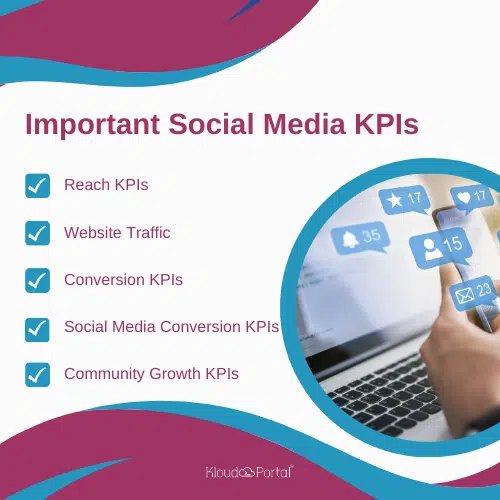Has your social media marketing strategy helped you achieve your goals?
Social media KPIs measure campaign performance reliably. They serve as predefined benchmarks for tracking performance. Tracking metrics such as engagement rate, follower count, and lead conversion rate will show evidence that your strategy bridges your target audience and establishes brand awareness.
In this blog post, we will learn about social media KPIs, how to set up social media KPIs, important social media KPIs, and important metrics for tracking social media KPIs.
Exploring Social Media Marketing KPIs
Key performance indicators (KPIs) are quantifiable performance measures over time for an object.
Companies use KPIs, including related metrics, to measure performance, check if the targets are being met, and change the strategies if required.
Social media KPIs determine the efficiency of a business’s social media marketing efforts and strategies. They track the company’s data on independent platforms such as Instagram, Facebook, Linkedin, etc. Social media KPIs include ‘Key metrics’ and ‘Key objectives.’ Key Objectives are the list of targets that need to be accomplished, and key metrics are the performance trackers.
Google Analytics can help businesses gain valuable insights into the impact of their social media efforts on website traffic and conversions by analyzing data alongside social media KPIs like engagement rates and click-through rates.
Why Use Social Media KPIs?
- Social media KPIs help pinpoint particular objectives and measure their improvements, giving a brief picture of what’s going right, where to concentrate efforts, and telling how well the strategy is designed to meet the goals.
- Social media KPIs brief about the change in desirable outcomes for the efforts made. For example, whether the new feature added to social media platforms leads to follower growth.
- Lastly, they help you analyze and execute weak areas that can lead to the overall growth of your business.
Important Social Media KPIs
Let us look at some important social media KPIs.
Reach KPIs
Reach is a quantity measurement, and ‘Reach KPIs’ measure the user count of your social media channels.
- Impressions- This number gives the visibility count of your post on the user’s feed or timeline.
- Follower count – Displays the no of followers.
- Audience growth rate – It demonstrates the follower count concerning time.
- Reach – It provides the post engagement rate and profile visits after posting.
- Potential reach – It provides the count rate of people viewing a particular post during a reported period.
A good content marketing service will ensure good planning, research, creation, and analysis of social media content to attract, engage potential customers, and generate leads.
Website traffic
Website traffic, including visits to your landing page, is another valuable social media KPI for tracking. It provides the count of users visiting your website on social media platforms.
Conversion KPIs
Conversion metrics show how good your social media strategy is and how well it leads to actionable insights.
- Conversion rate – It gives the count of users who performed the tasks outlined by your social media CTA compared to the total clicks on that particular post.
- Cost per click (CPC) – The amount paid to the social media platform for an individual clicks on sponsored posts.
- Click-through rate (CTR) – It gives the percentage of users who viewed the post and clicked on CTA (call to action) included.
- Cost per thousand impressions (CPM) – You pay for every 1000 views for your sponsored social posts.
- Bounce rate – It gives the percentage of users who clicked the link provided by your post but left the page without taking action.
- Revenue – It shows sales revenue generated through the social media platform.
Tying up with a Digital marketing company can ensure your increment in online presence and integrate your online platforms and profiles through a wide range of strategies, tactics, and other online tools.

Social media engagement KPIs
Social media engagement KPIs compute the quality of interactions with social media followers. It briefs about the audience’s connection with your video content, posts, and branding.
- Likes – It counts user engagement with social media posts by clicking the like button.
- Mentions – It indicates the brand mentions tagged on posts.
- Clicks – It gives the count of clicks on the link provided by your social media post.
- Applause rate – It tracks positive interactions such as retweets, reposts, likes, saves, etc.
- Comments – It gives the count of followers’ comments on a post.
- Shares – It gives the no of times your post has been shared from one platform to another.
- Amplification rate – It gives the rate of your followers sharing your content with their followers.
- Average engagement rate – This metric divides the engagement a post receives, including saves, favorites, likes, comments, etc., by the total count of your social channel.
A Best Digital Marketing Agency excels in managing your social media accounts, creating and publishing content, optimizing website pages, and executing SEO strategies to enhance your brand’s visibility on search engine result pages. (made changes)
Community growth KPIs
These KPIs keep track of your community growth rate.
- Total subscribers – It gives the total count of subscribers attracted over time.
- New subscribers – It gives the total count of users subscribed to your social media page over time.
Setting Up Social Media KPIs
Let us look at some ways to set up social media KPIs.
- Stating the KPI’s objectiveThe KPIs objective indicates how tracking the KPI can help the company reach a particular business goal. It is beyond numbers and data.
- Name the KPIDeciding on a metric will measure whether it is on a track. For instance, if your company focuses on growth and intends to increase brand awareness, you could make Facebook impressions as one of the KPIs. After setting a metric, adding value and timeline to the KPI is important.
- Share your KPIsCommunicate your KPIs with your team, boss, and other stakeholders who stay current with your strategies. Sharing your KPIs would set the expectations right and align with your measurements.
- Analyze performanceAnalyzing social media performance concerning time is an important step to follow.
- Understanding industry benchmarksUnderstanding industry benchmarks is important for setting realistic business goals for your social media account.
Important Social Media Metrics
Let us discuss some important social media metrics that help to track social media marketing.
Impressions
It is a key metric that checks if the marketing efforts are being reached to the social media audience. More impressions indicate a high visibility rate.
New followers
New followers are the users who lately follow your social media channels and have access to your latest posts in their newsfeeds.
Share of voice
It is a social media metric that measures the market your brand owns or the intensity of your domination in the industry compared to your competitors.
Follower-drop-off rate
This metric gives the number of users who have unfollowed your social media page over a period.
Follower-growth rate
It is an essential metric that measures the total number of followers gained over a particular period.
Conclusion
Social media is a web of interactions that makes it unique and easy to interact but difficult to measure. As social media managers and marketers, it is important to watch the competition, quality content, and audience growth rate. These insights provide information on where to invest time, money, and resources for building relationships within the social network.
The best social media marketing agency in Hyderabad can help you reach high search rankings, improve customer reach and target audience, and benefit you in various ways for your YouTube channel, LinkedIn page, and other platforms.

Amulya Sukrutha
About The Author…
Amulya Sukrutha, passionate computer science engineer specialized in Data science field. I also describe myself as a enthusiastic strength and endurance trainee. I have played professional Tennis during my early years and found my path in Software development and machine learning later. I’m also passionate about creating content, and learning about new technologies.

